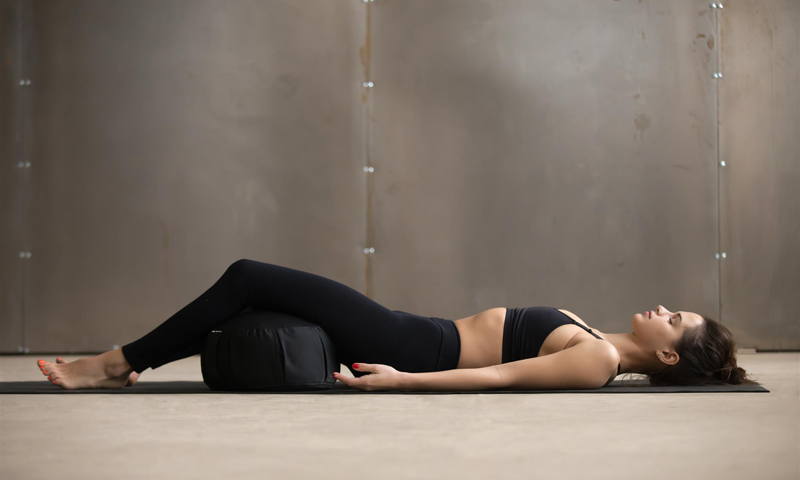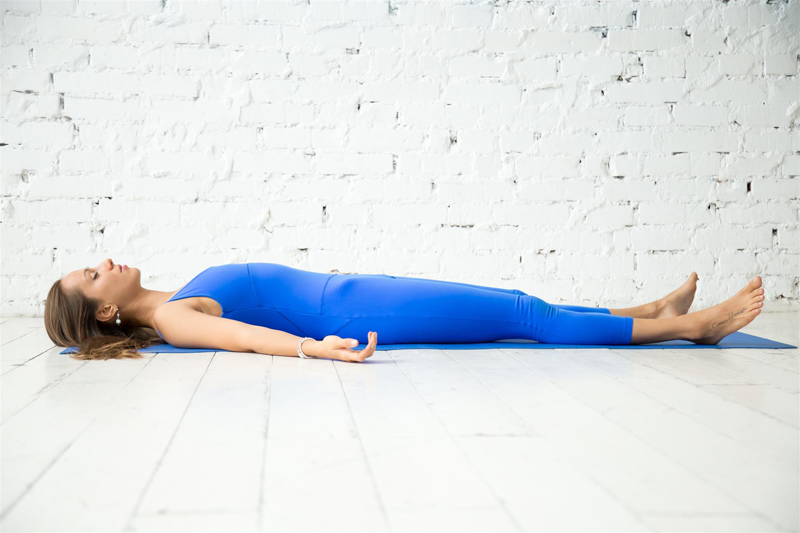
What are Mudras?
22nd June 2018
How to do Downward-Facing Dog pose in yoga
26th June 2018How to do corpse pose in yoga

Yes, this is a pose that invites you to position yourself like you are playing dead. Grab one of our oversized sweatshirts to keep yourself warm, lay on the floor, and do stillness.
Another name for corpse pose is Mrtasana, which means death pose in Sanskrit. This is obviously not the hardest pose in the world – and you are likely to be able to lie there – playing dead – for many hours. But, there are challenges to becoming a corpse that are worth addressing, and practising, and perfecting – to become the ultimate yogi. Also known as Savasana, this corpse pose is the pose of complete relaxation – and this is where it becomes difficult.
The benefits of this pose
This pose helps to calm the brain and relieve stress. It relaxes the body and therefore reduces the chance of headaches, fatigue, insomnia, anxiety and depression. It also helps to lower blood pressure. The transitioning from workout to stillness also helps to avoid adrenal burnout – as the body has time to process the adrenalin created by exercise before moving on. This balancing of the adrenal system is what will ultimately reduce stress and prevent digestive problems – as the fight and flight mode is countered and the parasympathetic nervous system eased.
Ultimately, this is the pose for the mind and the challenge is within the mind – not within the body. Anything that your body does here reflects the quality of calm in the mind. Therefore, mastering this pose is about bringing stillness to everything.
One of the great physical benefits of the corpse pose is the ability to listen to your body. With the mind quietened you will be able to address the areas of your body that might need attention. You might feel the twinge in the knee, or the ache in the ankle – and so take steps to prevent injury in the future by being proactive.
Instructions
- This is a restorative pose; therefore, the body should be in neutral position. You should begin sat on the floor with your knees bent and feet on the floor.
- Now, lean back onto your forearms and lift your pelvis slightly off the floor.
- Using the hands, lift the tailbone off the floor by lifting the pelvis to the ceiling. Then, release and relax the area back towards the floor, softening the groin.
- Exhale whilst extending the right leg, pushing through the left heal.
- Exhale and extend the left leg, making sure both legs are evenly angled in relation to the mid-line of the torso.
- Turn the feet out equally.
- Soften the lower back into the floor.
- Using the hands, lift the head off the floor and lower it back down, with the neck pulling towards the tailbone. Make sure your ears are equal distance from your shoulders.
- Reach your arms up to the ceiling and rock slightly from side to side, then release the arms to the floor. Make sure the shoulder blades are placed evenly on the floor.
- It is also important to soften the organs of the body. Soften the tongue, the nostrils in the nose and relax the skin across the forehead – particularly in the bridge of the nose. Let your eyes sink back into your head and turn your gaze to your heart. Let your brain sink to the beck of the head.
- Maintain the pose for 5 minutes, every 30 minutes of practice. Exit the pose by rolling first onto one side before sitting up.

Tips
Here we are symbolically dying – therefore, when in corpse pose, we should literally feel nothing with our bodies. As your body is completely evenly and neutrally placed against the floor, it should be at rest. Only your ears should be alert to the sound of your breath.
Then, comes the hard bit.
You then need to surrender all effort of the mind. It should stop its labours in trying to make sense of the past, foresee the future, understand the present. The brain should drop to the back of the skull where you will abandon nothing, take up nothing, just rest and abide just as you are in the present.
If at first you find the emptying of the mind impossible – start by turning your senses to the physical sensation of your body touching the floor. Take a journey around the body, scanning it from toe, to heel, to ankle and so on. This is a first step towards turning off the thoughts that are not always within our control.
To perfect the pose
The point of Savasana is to take a mini vacation from any movement or thought. This is the process of emptying your mind – and in a busy world – this is hard. Movement towards perfection is about how well you can really take a break. It is likely at first that your brain will run through its to-do list, it may replay an event from the day, maybe even send up an earworm to sing a song to you. If this is your head – then you need to try for taking a break even more than most. So, aim for an emptying of the thoughts – and a setting aside of the committee of voices that normally commentate on your day.
This pose might seem like the opposite of exercise – but you will begin to realise that it is hard work accepting the gift of a few minutes peace and quiet. We are too busy in our lives, too pushed to be active and drive on each and every moment. This pose could be the most challenging one your practise because you don’t have to do anything – in a world where we are encouraged to constantly act. Treat yourself to some of our glorious yoga pants, to ensure you are dressed perfectly for rest, and settle into getting good at comforting yourself by being still.

